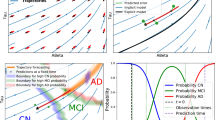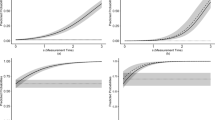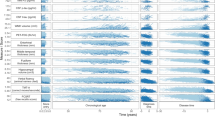Abstract
Alzheimer’s disease (AD) progresses from a preclinical period, through a middle phase of cognitive deterioration, to a late, profound state. The temporal progression of disability can be modeled with a horologic (time-based) function using “time-index” (TI) intervals (day-or yearunits) to quantify an individual’s disability across multiple cognitive and functional domains relative to a reference AD population. Clinicians and researchers can use TI quantification to assess dementia severity and initial therapy benefits. Rate of progression and confidence intervals require at least two successive measurements. Rate of progression measures can be used to support diagnosis and to investigate disease-course-modifying therapies.
Similar content being viewed by others
References and Recommended Reading
Ashford JW, Shan M, Butler S, et al.: Temporal quantification of Alzheimer’s disease severity: ‘time index’ model. Dementia 1995, 6:269–280.
Ashford JW, Schmitt F, Kumar V: Diagnosis of Alzheimer’s disease. In Advances in the Diagnosis and Treatment of Alzheimer’s Disease. Edited by Kumar V, Eisdorfer C. New York: Springer Publishing; 1998. This chapter gives an in-depth description of the diagnosis of AD, including early detection, and a full description of the average time-course of the disease.
Reisberg B, Sclan SG, Franssen E, et al.: Commentary: Dementia staging in chronic care populations. Alz Dis Assoc Dis 1994, 8:S188-S205.
Brooks JO, Kraemer HC, Tanke ED, Yesavage JA: The methodology of studying decline in Alzheimer’s disease. J Am Ger Soc 1993, 41:623–628.
Larrabee GJ, Crook TH: Estimated prevalence of ageassociated memory impairment derived from standardized tests of memory function. Int Psychogeriatr 1994, 6:95–104.
Butler M, Ashford JW, Snowdon DA: Age, education, and changes in the mini-mental state exam scores of elderly women. J Am Ger Soc 1996, 44:675–681.
Unger JM, van Belle G, Heyman A: Cross-sectional versus longitudinal estimates of cognitive change in nondemented older people: a CERAD study. J Am Geriatr Soc 1999, 47:559–563.
Schmitt FA, Davis DG, Wekstein DR, et al.: “Preclinical” AD revisited: neuropathology of cognitively normal older adults. Neurology 2000, 55:370–376. This recent paper describes the relation of subclinical memory impairment to Alzheimer pathologic changes. It also reviews this important issue.
Schmitt FA, Ashford JW, Ernesto C, et al.: The Severe Impairment Battery: concurrent validity and the assessment of longitudinal change in Alzheimer’s disease. Alz Dis Assoc Dis 1997, 11:S51-S56.
Mediondo MS, Ashford JW, Kryscio RJ, Schmitt FA: Modeling mini-mental state exam changes in Alzheimer’s disease. Statist Med 2000, 19:1607–1616. This is a recent analysis by the authors, showing mathematic variations and the influence of age, gender, and education on the temporal progression of AD.
Liu X, Teresi JA, Waternaux C: Modelling the decline pattern in functional measures from a prevalent cohort study. Statist Med 2000, 19:1593–1606. This rigorous mathematic paper discusses alternative approaches to model the nonlinear progression of dementia in AD. However, these approaches are essentially the inverse of the one described in the current paper.
Liu X, Tsai W-Y, Stern Y: A functional decline model for prevalent cohort data. Statist Med 1996, 15:1023–1032.
Stern Y, Liu X, Albert M, et al.: Application of a growth curve approach to modeling the progression of Alzheimer’s disease. J Gerontol Med Sci 1996, 51:M179-M184.
Ashford JW, Kumar V, Barringer M, et al.: Assessing Alzheimer severity with a global clinical scale. Int Psychogeriatr 1992, 4:55–74.
Weiss DJ, Yoes ME: Item response theory. In Advances in Educational and Psychological Testing: Theory and Applications. Edited by Hambleton RK, Zaal JN. Boston: Kluwer Academic Publishers; 1991:69–95.
Yen M, Edwardson SR: Item-response theory approach in scale development. Nurs Res 1999, 48:234–238.
Hambleton RK, Swaminathan H, Rogers HJ: Fundamentals of Item Response Theory. New Bury Park, CA: Sage Publications; 1991.
Ashford JW, Kolm P, Colliver JA, et al.: Alzheimer patient evaluation and the mini-mental state: item characteristic curve analysis. J Gerontol 1989, 44:P139-P146.
Teresi JA, Cross PS, Golden RR: Some applications of latent trait analysis to the measurement of ADL. J Gerontol 1989, 44:S196-S204.
Teresi JA, Golden RR, Cross P, et al.: Item bias in cognitive screening measures: comparisons of elderly white, Afro-American, Hispanic and high and low education sub-groups. J Clin Epidemiol 1995, 48:473–483.
Teresi JA, Kleinman M, Welikson-Ocepek K: Modern psychometric methods for detection of differential item functioning: application to cognitive assessment measures. Statist Med 2000, 19:1651–1683. This application of IRT to the study of AD contains an in-depth discussion of methods for detecting differential item functioning in AD. However, the reference scale is not related to the time-base of AD progression.
Woodard JL, Auchus AP, Godsall RE, Green RC: An analysis of test bias and differential item functioning due to race on the Mattis Dementia Rating Scale. J Gerontol 1999, 53:P370-P374.
Mungas D, Reed BR: Application of item response theory for development of a global functioning measure of dementia with linear measurement properties. Statist Med 2000, 19:1631–1644. This is a recent, fundamental application of IRT to dementia assessment in AD.
Stevens SS: On the theory of scales of measurement. Science 1946, 103:677–680.
Wang S-T, Yu M-L, Wang C-J, Huang C-C: Bridging the gap between the pros and cons in treating ordinal scales as interval scales from an analysis point of view. Nurs Res 1999, 28:226–229.
Brooks JO, Yesavage JA, Taylor J, et al.: Cognitive decline in Alzheimer’s disease: elaborating on the nature of the longitudinal factor structure of the mini-mental state examination. Inter Psychoger 1993, 5:135–146.
Roses AD: The Alzheimer diseases. Cur Neurol 1994, 14:111–141.
Eisdorfer C, Cohen D, Paveza GJ, et al.: An empirical evaluation of the global deterioration scale for staging Alzheimer’s disease. Am J Psychiatry 1992, 149:190–194.
Murphy GM, Taylor J, Kraemer HC, et al.: No association between apolipoprotein E e4 allele and rate of decline in Alzheimer’s disease. Am J Psychiatry 1997, 154:603–608.
Cohen D, Eisdorfer C, Gorelick P, et al.: Psychopathology associated with Alzheimer’s disease and related disorders. J Gerontol 1993, 48:M255-M260.
Teri L, McCurry SM, Edland SD, et al.: Cognitive decline in Alzheimer’s disease: A longitudinal investigation of risk factors for accelerated decline. J Gerontol 1995, 50:M49-M55.
Milliken JK, Edland SD: Mixed effect models of longitudinal Alzheimer’s disease data: a cautionary note. Statist Med 2000, 19:1617–29.
Ashford JW, Jarvik L: Alzheimer’s disease: does neuron plasticity predispose to axonal neurofibrillary degeneration? N Engl J Med 1985, 5:388–389.
Ashford JW, Mattson M, Kumar V: Neurobiological Systems Disrupted. In Advances in the Diagnosis and Treatment of Alzheimer’s Disease. Edited by Kumar V, Eisdorfer C. New York: Springer Publishing; 1998.
Ashford JW, Soultanian NS, Zhang S-X, Geddes JW: Neuropil threads are colinear with MAP2 immunostaining in neuronal dendrites of Alzheimer brain. J Neuropath Exp Neurol 1998, 57:972–978.
Folstein MF, Folstein SE, McHugh PR: “Mini-Mental State”: a practical method for grading the cognitive state of patients for the clinician. J Psychiatr Res 1975, 12:189–198.
Tombaugh T, McIntyre NJ: The mini-mental state examination: a comprehensive review. J Am Geriatr Soc 1992, 40:922–935.
Kraemer HC, Taylor JL, Tinklenberg JR, Yesavage JA: The stages of Alzheimer’s disease: a reappraisal. Dement Geriatr Cogn Disord 1998, 9:299–308. This review of the approaches to staging AD provides a relevant discussion of the strengths and weakness of the MMSE and GCS. It suggests under what circumstances various approaches should be considered.
Morris JC, Edland S, Clark C, et al.: The Consortium to Establish a Registry for Alzheimer’s Disease (CERAD): Part IV. Rates of cognitive change in the longitudinal assessment of probable Alzheimer’s disease. Neurology 1993, 43:2457–2465.
Galasko DR, Gould RL, Abramson IS, Salmon DP: Measuring cognitive change in a cohort of patients with Alzheimer’s disease. Statist Med 2000, 19:1421–1432.
Stern RG, Mohs RC, Davidson, et al.: A longitudinal study of Alzheimer’s disease: measurement, rate, and predictors of cognitive deterioration. Am J Psychiatry 1994, 151:390–396.
Mitnitski AB, Graham JE, Mogilner AJ, Rockwood K: The rate of decline in function in Alzheimer’s disease and other dementias. J Gerontol 1999, 54:M65-M69.
van Belle G, Arnold A: Reliability of cognitive tests used in Alzheimer’s disease. Statist Med 2000, 19:1411–1420.
Stern Y, Albert S, Tang M-X, Tsai W-Y: Rate of memory decline in AD is related to education and occupation: Cognitive reserve? Neurology 1999, 53:1942–1947.
Jobst KA, Hindley NJ, King E, Smith AD: The diagnosis of Alzheimer’s disease: A question of image? J Clin Psychi 1994, 55[suppl 11]:22–31.
Shih W-J, Ashford JW, Stipp V, et al.: Consecutive brain SPECT surface three-dimensional displays show progression of cerebral cortical abnormalities in Alzheimer’s disease. Clin Nuc Med 1999, 24:773–777.
van Belle G, Uhlmann RF, Hughes JP, Larson EB: Reliability of estimates of changes in mental status test performance in senile dementia of the Alzheimer type. J Clin Epidemiol 1990, 43:589–595.
Clark CM, Sheppard L, Fillenbaum GG, et al.: Variability in annual mini-mental state examination score in patients with probable Alzheimer’s disease. Arch Neurol 1999, 56:857–862.
Teri L, Hughes JP, Larson EB: Cognitive deterioration in Alzheimer’s disease: behavioral and health factors. J Gerontol 1990, 45:P58-P63.
Magni E, Binetti G, Padovani A, et al.: The mini-mental state examination in Alzheimer’s disease and multi-infarct dementia. Int Psychoger 1996, 8:127–134.
Blessed G, Tomlinson BE, Roth M: The association between quantitative measures of dementia and of senile change in the cerebral gray matter in elderly subjects. Br J Psychiatry 1968, 114:797–811.
Geddes JW, Tekirian TL, Soultanian NS, et al.: Comparison of neuropathologic criteria for the diagnosis of Alzheimer’s disease. Neurobiol Aging 1997, 18:S99-S105.
Braak H, Braak E: Staging of Alzheimer’s disease-related neurofibrillary changes. Neurobiol Aging 1995, 16:271–284.
Ohm TG, Scharnagl H, Marz W, Bohl J: Apolipoprotein E isoforms and the development of low and high Braak stages of Alzheimer’s disease-related lesions. Acta Neuropathol (Berl) 1999, 98:273–80.
Ashford JW, Shih W-J, Coupal J, et al.: Single SPECT measures of cerebral cortical perfusion reflect “time-index” estimation of dementia severity in Alzheimer’s disease. J Nuc Med 2000, 41:57–64.
Small GW, Kuhl DE, Fujikawa DG, Ashford JW: Clinical characterization of Alzheimer’s disease: reliability of ‘age at onset’ and a new descriptor, ‘age at shift.’ J Ger Psychiatr Neurol 1988, 1:207–211.
Ashford JW, Schmitt FA, Wermeling D, et al.: Advantages of the “time-index” method for measurement of Alzheimer dementia: assessment of metrifonate benefit. In Alzheimer Disease: From Molecular Biology to Therapy. Edited by Becker R, Giacobini E. Boston: Birkhauser; 1996.
Helmes E, Merskey H, Hachinski VC, Wands K: An examination of psychometric properties of the extended scale for dementia in three different populations. Alz Dis Assoc Disord 1993, 6:236–246.
Fillenbaum GG, Wilkinson WE, Welsh KA, Mohs RC: Discrimination between stages of Alzheimer’s disease with subsets of mini-mental state examination items. Arch Neurol 1994, 51:916–921.
Author information
Authors and Affiliations
Rights and permissions
About this article
Cite this article
Ashford, J.W., Schmitt, F.A. Modeling the time-course of Alzheimer dementia. Curr Psychiatry Rep 3, 20–28 (2001). https://doi.org/10.1007/s11920-001-0067-1
Issue Date:
DOI: https://doi.org/10.1007/s11920-001-0067-1




